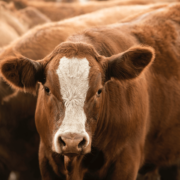Docility and Structure – The Foundation for all Good Bull Buying Decisions
With bull sale season looming, its timely to take stock of where your herd sits right now, and where you want it to be in ten years’ time.
Regardless of the above, commercial farmers all have one thing in common in that selecting the right bulls for their individual breeding programmes is one of the most important and often complex decisions they make in their operation, and a direct contributor to overall profitability.
The reason for this is simple – in a commercial beef herd, the bull is what drives the genetic improvement, so the decision you make about which bull to buy this season will affect your business for on a long-term scale.
At Gold Creek, we believe that the starting point for this all-important task of selecting which bulls to buy should start at the basics – docility and structure -both of which are highly heritable traits and both of which stand to have a substantially positive impact on the longevity of the females in your herd.
If you don’t get these right you run the risk of incurring the cost of a higher turnover rate in your bulls if they are consistently breaking down at a younger age. A bull can be the star of the show with regards to one or many other traits but without structure and docility as the foundation you are limiting the potential of your operation, in our view, quite significantly.
—
Docility
Docility as a trait can have a significant influence on your bottom-line, as well as the associated health and safety risks when handling aggressive cattle. Let’s be honest – we would all rather be raising quiet and easy to handle cattle over a fighty and aggressive bunch, but the importance of docility doesn’t stop there.
Numerous studies have highlighted the fact that docile cattle are likely to reach heavier weaning weights and finish faster which of course comes with a financial reward. They also maintain lower pH levels which has a bearing on how they grade at slaughter and whether or not they qualify for the ‘eating quality’ premiums that many meat processors now offer. It is well known that pH levels have a big influence on meat tenderness, and that they are raised when animals come under stress through the production of cortisol.
Structure
The structural soundness of a bull affects his ability to thrive in a herd – this includes both the rigid skeletal structure to the softer tissues which are critical to bull function.
A bull must be capable of walking long distances and across New Zealand hill country, all whilst maintaining strong body condition. He should be able to efficiently detect and serve females on heat. Soundness of limb and skeletal structure contribute significantly to the bull’s longevity and functional effectiveness.
Conformation (particularly hind limb) of the legs and hooves, head and eyes, pelvic size, scrotal circumference and testicular tone, sheath size and shape are all important features of the functional anatomy to consider.
Make sure you ask your stud breeder how they assess their structure – ideally it is independently evaluated and therefore free from bias. It is also a good idea to familiarise yourself with the basics of the beef class assessment system which you can find on our website here
Practice this assessment on your own cattle when culling cows/heifers so you have a better understanding when you are next purchasing your bulls.
—
At Gold Creek we are passionate about breeding cattle that will add value for our customers through an enhanced bottom line. We take the time to get to know your breeding programme because we know how important it is in ensuring you select the right bulls to compliment this.
If you can get docility and structure right in your herd you have a great foundation from which to grow and enhance your herd through other traits.



